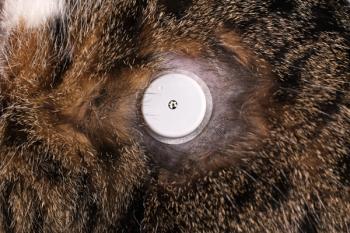
A fool-proof method for managing hypothyroidism in dogs
Canine hypothyroidism, while a common endocrinopathy in the dog, may be over diagnosed due to confusion/inconsistencies in establishing a definitive diagnosis.
Canine hypothyroidism, while a common endocrinopathy in the dog, may be over diagnosed due to confusion/inconsistencies in establishing a definitive diagnosis.
Etiology/pathophysiology
Hypothyroidism is due to decreased thyroidal production of the thyroid hormones thyroxine (T4) and triiodothyronine (T3). Greater than 90% of cases are primary and are due to acquired immune mediated destruction of the thyroid gland which is preceded by thyroiditis, idiopathic atrophy or less commonly neoplasia. Secondary forms of the disease include thyroid stimulating hormone (TSH) deficiency, pituitary neoplasia, and cystic Rathke's pouch, are uncommon clinical entities. Tertiary hypothyroidism with thyrotropin releasing hormone (TRH) deficiency has not been documented in dogs. Congenital cases have been reported in both dogs and cats.
Signalment/history
Hypothyroidism most commonly occurs in young to middle aged dogs with an average age of 7 years. Dogs with autoimmune disease tend to develop hypothyroidism at a younger age. While thyroid values decrease within the reference range in senior dogs, hypothyroidism is very uncommon and other factors (see below) are likely responsible for the observed decreased thyroid concentrations in euthyroid older patients. Spayed females and neutered males are at an increased risk when compared to sexually intact animals. Breed predispositions have been reported for golden retrievers and Doberman pinschers. Thyroiditis is heritable in the beagle, Borzoi, golden retriever, great Dane, Irish setter, Doberman pinscher, and old English sheepdogs.
Risk factors
No known environmental factors have been identified. Breed predispositions as outlined above.
Historical findings
As thyroid hormone regulates the metabolic rate and influences the functions of many organs, clinical signs are often non-specific and insidious in onset. Many other diseases can have similar clinical signs to hypothyroidism, which may lead to an incorrect diagnosis. As such laboratory testing of thyroid function is often performed as part of the diagnostic work in animals with non-thyroidal illness.
Clinical features
Common clinical signs include lethargy, mental dullness, weight gain, exercise intolerance, alopecia, and obesity.
Differential diagnosis
Many metabolic, infectious, neoplastic, congenital, degenerative, and inflammatory diseases can cause similar clinical signs and biochemical abnormalities seen with hypothyroidism.
Diagnostics
Laboratory diagnosis
Thyroxine is the major secretory product of the thyroid while the majority of T3 is derived from extra-thyroidal sources. Both T4 and T3 are highly protein bound to serum carrier proteins such as thyroid binding globulin, transthyretin and albumin. Only unbound (free) hormone is able to penetrate cell membranes, bind to receptors and result in biologic activity. Protein bound hormone acts as a reservoir to maintain steady concentrations of free hormone in the plasma despite rapid alterations in release and metabolism of T3 and T4 and changes in the plasma protein concentrations.
Serum total T4
Serum T4 is a sensitive (>90-95%), but not specific test (70-75%) for the diagnosis of canine hypothyroidism. The vast majority of dogs with hypothyroidism have a serum T4 below normal, but some normal dogs and those with a variety of other problems may have a low serum T4. A diagnosis of hypothyroidism can be ruled out if the T4 is in the upper 50% of the reference range. Autoantibodies to T4 occur in about 15% of hypothyroid dogs, and these antibodies may falsely increase the serum T4 concentration from below normal into or above the normal range. In house testing of TT4 is not recommended.
Serum total T3
Serum T3 concentration is an unreliable test for evaluation of thyroid function.
Serum free T4 (fT4)
Thyroxine is highly (99.9%) protein bound in the circulation. Protein binding can be altered by many nonthyroidal illnesses and by certain drugs. Measurement of the unbound or free hormone can provide a more accurate assessment of thyroid function in these cases (sensitivity > 95%, specificity > 97%). The sensitivity of fT4 is equivalent to or slightly better than total T4 in diagnosing hypothyroidism in routine cases. More importantly, fT4 is more specific, particularly when non-thyroidal factors that can influence total T4 are present. Free T4 is less affected by most non-thyroidal illness and drugs, but still can be altered in cases of moderate to severe illness. In addition, fT4 by equilibrium dialysis is not affected by the presence of T4 autoantibodies that will falsely elevate total T4. Measurement of fT4 by equilibrium dialysis should be performed when uncommon clinical signs of hypothyroidism are present, the dog is being treated with a drug that may affect thyroid function, when non-thyroidal illness is present, and if autoantibodies to T4 are detected.
Serum TSH
Primary hypothyroidism results in a decrease in T4 and thus decreased negative feedback on the pituitary gland. In response, the pituitary secretes more TSH and plasma TSH levels increase. In man, TSH is elevated prior to any decrease of T4 or fT4 outside the normal range. In the dog, TSH concentration is elevated in only 65-75% of cases of hypothyroidism, as such it lacks sensitivity for use as a screening test. The combination of decreased total T4 or fT4 with an elevated serum TSH is diagnostic of hypothyroidism (specificity > 95%). Therefore, a normal TSH does not rule out hypothyroidism, but an elevated TSH combined with a low T4 or fT4 provides a definitive diagnosis.
Diagnosis of thyroiditis
Antibodies against either T4 or T3 or both are sometimes present in dogs with thyroiditis with or without hypothyroidism. The presence of these antibodies does not indicate that the dog is hypothyroid, but suggests that autoimmune thyroid disease is present. These antibodies frequently cause false elevation of T4 or T3 concentrations that can result in marked elevation of the hormones. Autoantibodies to T4 are present in about 10-15% of hypothyroid dogs.
Dogs with autoimmune thyroiditis may have circulating antibodies to thyroglobulin, the primary protein in the colloid of the thyroid gland. This is not a test of thyroid function, but rather a marker for the presence of autoimmune thyroiditis. In one long-term study at Michigan State University, 20% of asymptomatic, antithyroglobulin positive dogs with normal thyroid function progressed to hypothyroidism in 1 year. The presence of these antibodies in a dog with borderline laboratory evidence of hypothyroidism and clinical signs supports a diagnosis of hypothyroidism.
Additional considerations
Breeds
Certain breeds have normal ranges of thyroid hormones that are different from most other breeds. Few have been evaluated, but greyhounds have serum total T4 and fT4 concentrations that are considerably lower than most other breeds. Scottish deerhounds, Saluki's and whippets also have total T4 concentrations that are well below the mean concentration of dogs in general. Alaskan sled dogs have serum T4, T3, and fT4 concentrations that are below the reference range of most pet dogs, particularly during periods of intense training or racing.
Time of day
In one study 50% of normal dogs had a low serum T4 concentration at some time during the day.
Medications
The drugs that are known to commonly alter thyroid function tests are glucocorticoids, phenobarbital, sulfonamides, clomipramine, aspirin, and some other NSAIDs. Glucocorticoids suppress total T4 and sometimes fT4 as well. Phenobarbital causes decreased total T4 and mild increases in TSH. Sulfonamides can induce overt primary hypothyroidism with clinical signs and thyroid function tests that support the diagnosis. The changes may be reversible when the medication is discontinued. There are dozens of drugs that affect thyroid function and thyroid function tests in man, so many others likely affect the dog as well.
Nonthyroidal illness
Illness not involving the thyroid gland can alter thyroid function tests and has been labeled "non-thyroidal illness" or "euthyroid sick syndrome". Any illness can alter thyroid function tests, causing a fairly consistent decrease in total T4 and T3 concentrations in proportion to the severity of illness. Serum TSH concentration is increased in 8-10% of dogs with non-thyroidal illness. Serum fT4 measured by equilibrium dialysis is less likely to be affected, but can also be increased or decreased. However, in dogs with substantial non-thyroidal illness, the fT4 is likely to be decreased. It is recommended that testing of thyroid function be postponed until the non-thyroidal illness is resolved. If this is not possible, measurement of T4, TSH and fT4 are indicated.
Ancillary testing
Thyroid gland ultrasound
Although rarely necessary, ultrasound of the thyroid glands (by an experienced ultrasonographer) can be used to aid in differentiating dogs with primary hypothyroidism from those with non-thyroidal illness. Thyroid glands of hypothyroid dogs tend to be smaller, less homogeneous, and hypoechoic than those of euthyroid dogs. There is considerable overlap with the ultrasonographic appearance and size of the thyroid glands of euthyroid and hypothyroid dogs. Thyroid ultrasound can only be used to help support a diagnosis of hypothyroidism if the thyroid glands are quite small.
Therapeutics
Drugs
Levothyroxine is the only hormone that appears necessary for treatment of hypothyroidism. The frequency of levothyroxine dosing is controversial, and the only study to closely evaluate the response to treatment showed that once daily treatment is adequate. However, in clinical practice some dogs seem to respond better to twice-daily treatment.
The initial starting dose is 0.02 mg/kg PO q 24 h. In general you will never have to exceed exceed 0.8 mg as an initial daily dosage even in very large dogs. If the dog has significant cardiovascular disease, diabetes mellitus, or hypoadrenocorticism, treatment should be instituted at 25% of the standard dose, with the dosage increased by 25% every 2 weeks based on clinical response and post-pill testing. Most dogs show improvement within the first 1-2 weeks, with increased activity, improved attitude, and partial or complete resolution of neurologic signs. The cutaneous manifestations of hypothyroidism may take several weeks to months to resolve. Post treatment monitoring may be carried out but clinical response is the most important monitoring tool. Peak T4 concentrations generally occur 4-6 hours after administration of levothyroxine and should be in the high normal to slightly above normal range (40-70 nmol/L). However, the bioavailability of thyroxine ranges from 13 to 87% in the same dog from day to day bringing into the question the utility of random post pill monitoring of TT4. It is likely more meaningful (though more expensive) to measure TSH (especially if the TSH concentration was elevated pre-treatment) or fT4 concentrations after replacement therapy has been started, especially in animals that show a poor clinical response to therapy. Serum TSH concentrations should be in the normal range or undetectable and fT4 concentrations should be in the normal range. Serum concentrations of TSH and fT4 should not be performed until the patient has been on supplementation for at least 2 weeks. If the patient was initially started on twice daily therapy, treatment can be reduced to once daily treatment when a good clinical response has been obtained.
Hyperthyroidism is the most common complication of treatment with levothyroxine, but it is rare in dogs. Clinical signs are similar to those of hyperthyroidism in cats and the diagnosis is confirmed by documenting a substantial elevation of serum T4. Treatment consists of stopping levothyroxine treatment for 2-3 days, then instituting treatment at a lower dose.
Comments
Expected course and prognosis
Response to therapy should be observed in the first 4- 8 weeks post treatment. Improvements in mentation and physical activity may be noted within the first week though some abnormalities, especially dermatologic signs, may take several months to resolve. An absent or incomplete response to therapy may be due to an incorrect diagnosis, poor owner compliance, inadequate dosing, or poor absorption.
Newsletter
From exam room tips to practice management insights, get trusted veterinary news delivered straight to your inbox—subscribe to dvm360.




